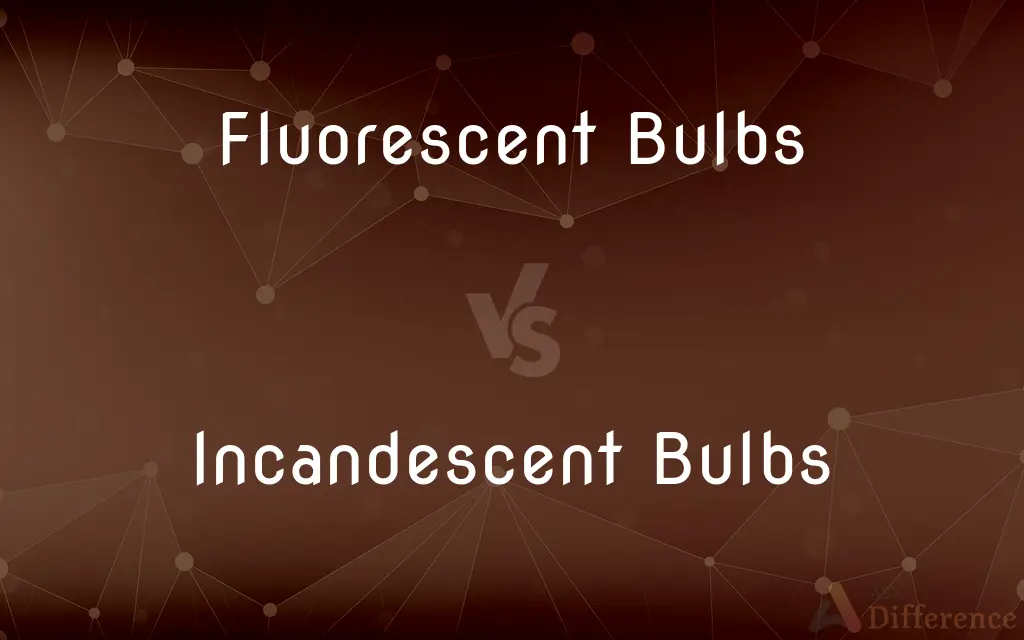Fluorescent Bulbs vs. Incandescent Bulbs — What's the Difference?
By Tayyaba Rehman & Urooj Arif — Published on February 15, 2024
Fluorescent bulbs use electricity to excite gas, producing UV light that is converted to visible light by a phosphor coating, offering energy efficiency. Incandescent bulbs heat a filament to produce light, being less energy-efficient.

Difference Between Fluorescent Bulbs and Incandescent Bulbs
Table of Contents
ADVERTISEMENT
Key Differences
Fluorescent bulbs and incandescent bulbs represent two distinct technologies in lighting. Fluorescent bulbs work by passing an electric current through a gas, typically argon and a small amount of mercury vapor, which produces ultraviolet (UV) light. This UV light then excites a phosphor coating on the inside of the bulb, emitting visible light. This process is more energy-efficient than incandescent bulbs, as less energy is wasted in the form of heat.
Incandescent bulbs, on the other hand, produce light by heating a tungsten filament until it glows. The filament is enclosed in a glass bulb containing an inert gas or a vacuum to prevent the filament from burning out quickly. This technology, while simpler and often providing a warmer light quality, is significantly less energy-efficient compared to fluorescent bulbs. A larger portion of the energy consumed is converted into heat rather than visible light.
One of the key differences between the two types of bulbs is their energy usage and efficiency. Fluorescent bulbs typically use about 25-35% of the energy that an incandescent bulb would use to provide the same amount of light, making them a more environmentally friendly option over the long term. They also tend to have a longer lifespan, further reducing their environmental impact by necessitating fewer replacements.
However, the choice between fluorescent and incandescent bulbs isn't solely based on energy efficiency and lifespan. Incandescent bulbs are often preferred for their instant illumination and ability to be dimmed, providing a cozier and more controllable lighting option for many. Fluorescent bulbs, while more energy-efficient, can sometimes emit a harsher light and take time to reach full brightness. They also contain mercury, a toxic substance that requires careful disposal.
In summary, the decision between using fluorescent bulbs and incandescent bulbs involves considering factors like energy efficiency, lifespan, light quality, environmental impact, and cost. Advances in lighting technology, such as the emergence of LEDs, continue to offer new alternatives, pushing traditional lighting options to evolve or become obsolete.
ADVERTISEMENT
Comparison Chart
Technology
Gas excitation and phosphor emission
Heating a tungsten filament
Energy Efficiency
Higher, less energy lost as heat
Lower, more energy converted to heat
Lifespan
Longer, typically around 7,000-15,000 hours
Shorter, about 750-2,000 hours
Light Quality
Can be harsher, takes time to warm up
Warm, instant illumination
Environmental Impact
Contains mercury, requires special disposal
Less energy-efficient, frequent replacements
Compare with Definitions
Fluorescent Bulbs
Requires careful disposal due to mercury content.
Dispose of used fluorescent bulbs at a designated recycling center.
Incandescent Bulbs
Traditional lighting with a tungsten filament.
The warm glow in the room came from an incandescent bulb overhead.
Fluorescent Bulbs
Known for their longer lifespan compared to incandescents.
We rarely have to replace the fluorescent bulbs in our kitchen.
Incandescent Bulbs
Less energy-efficient, converting more energy into heat.
Incandescent bulbs can make a room warmer due to their heat output.
Fluorescent Bulbs
May emit a cooler light spectrum.
Fluorescent bulbs provide a cool white light ideal for workspaces.
Incandescent Bulbs
Provides a warmer light, often preferred in homes.
I use incandescent bulbs for a cozy atmosphere in the living room.
Fluorescent Bulbs
Energy-efficient lighting that uses gas excitation.
The office was lit by bright fluorescent bulbs to save on energy costs.
Incandescent Bulbs
Shorter lifespan necessitates more frequent replacements.
I seem to replace the incandescent bulbs in the hallway often.
Fluorescent Bulbs
Contains a phosphor coating to convert UV light to visible light.
Fluorescent bulbs are coated inside to produce a bright, visible light.
Incandescent Bulbs
Offers instant illumination without warm-up time.
The incandescent bulb lit up immediately when I flipped the switch.
Common Curiosities
Which is more energy-efficient, fluorescent or incandescent bulbs?
Fluorescent bulbs are more energy-efficient.
Are incandescent bulbs being phased out?
Many countries are phasing out incandescents in favor of more efficient lighting.
Can I throw away used fluorescent bulbs in the trash?
No, fluorescent bulbs should be recycled due to their mercury content.
Do all fluorescent bulbs contain mercury?
Yes, all fluorescent bulbs contain a small amount of mercury.
Is the light from incandescent bulbs better for your eyes?
Some people prefer the warmer light of incandescents, finding it gentler.
Can fluorescent bulbs be used with dimmers?
Some fluorescent bulbs are compatible with dimmers, but not all.
Why do fluorescent bulbs sometimes flicker when turned on?
Flickering can occur as the gas inside the bulb becomes excited.
Do incandescent bulbs work with standard light fixtures?
Yes, they are compatible with most standard fixtures.
Can the mercury in fluorescent bulbs be hazardous?
Yes, if a bulb breaks, the mercury can be harmful, requiring careful cleanup.
Are there energy-efficient alternatives to both bulb types?
Yes, LED bulbs are more energy-efficient and longer-lasting.
Why do some people prefer incandescent bulbs despite their inefficiency?
The warm light and ability to dim make incandescents popular for home use.
Can fluorescent bulbs be used outdoors?
Yes, but their performance can be affected by extreme temperatures.
Do fluorescent bulbs really last longer than incandescent bulbs?
Yes, fluorescent bulbs have a longer lifespan than incandescent bulbs.
How can I dispose of incandescent bulbs?
Incandescent bulbs can be thrown in the trash, but recycling is encouraged.
Why do some fluorescent bulbs take time to reach full brightness?
The time is needed for the gas inside the bulb to fully excite and emit light.
Share Your Discovery

Previous Comparison
Euro vs. US Dollar
Next Comparison
Google Drive vs. DropboxAuthor Spotlight
Written by
Tayyaba RehmanTayyaba Rehman is a distinguished writer, currently serving as a primary contributor to askdifference.com. As a researcher in semantics and etymology, Tayyaba's passion for the complexity of languages and their distinctions has found a perfect home on the platform. Tayyaba delves into the intricacies of language, distinguishing between commonly confused words and phrases, thereby providing clarity for readers worldwide.
Co-written by
Urooj ArifUrooj is a skilled content writer at Ask Difference, known for her exceptional ability to simplify complex topics into engaging and informative content. With a passion for research and a flair for clear, concise writing, she consistently delivers articles that resonate with our diverse audience.
















































